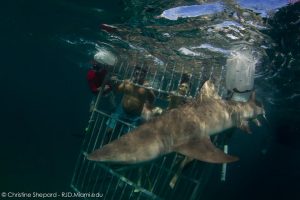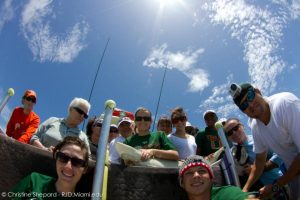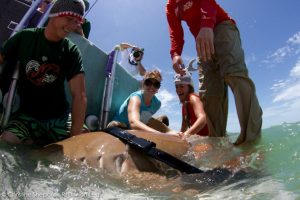Sunday, September 16th, 2012
by Laurel Zaima, RJD Intern
I woke up bright and early Sunday morning, and I was ecstatic to get out on the boat to conduct some “sharky” research! Unfortunately, it was a dark and blustery day in Coral Gables. I was afraid that my first trip of the semester was going to be cancelled. I began to take the necessary precautions by preparing myself for some bad news, but Captain Curt didn’t call off the trip. My fear was lifted and we were off to Islamorada! James, our fearless driver, led Kyra, Jon, and I safely through the thunderstorm and right on time. Captain Curt instructed us to shorten our normal lines because we were going to a shallow site, about 15 feet (4.572 meters) of water. Captain Curt anticipated the water to be a little choppy that day due to the dreary weather. Luckily, the weather actually cleared up, and it ended up being beautiful and sunny!
We were all very grateful for the weather cooperation because we wanted everyone to have an educational and hands on experience while conducting research. On this trip, we went out with an enthusiastic group called Experience Aviation and a couple of students from the University of Miami’s Abess Center for Ecosystem Science and Policy. Everyone was eager to get involved. Thanks to the assistance of our large group on board, we were able to swiftly and successfully deploy our first 10 drumlines! The initial drumlines that we pulled up were, unfortunately, shark-less, but we remained hopeful because some of the lines were also bait-less.
I was feeling lucky that day, so I cannot say that my “shark summoning talent” was the sole reason for pulling in the first shark. She was a beautiful, female Lemon Shark. She was small shark, only totaling a length of 170 cm (5.577 feet). After we conducted all of our necessary research, she was safely released back into the water in great condition. After our first catch of the day, the boat had a positive vibe and everyone was ready to catch another!
-
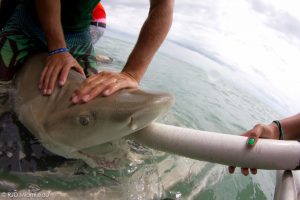
In order for a shark to obtain oxygen while we conduct research, a PVC pipe pumps salt water over the Lemon shark’s gills
One of the members of the Experience Aviation group volunteered to pull up a drumline, and he knew instantaneously that there was a strong and large shark on the line. This mysterious shark was running the line aggressively, so I grabbed the line to help. Another RJD intern held onto the volunteer to make sure he did not slip into the water. All of the sudden, the line went slack. I assumed the shark released himself from the line, but in actuality, he had broken the line off at the base of the weight! I guess this shark friend of ours will remain a mystery of the sea!
Our next catch was another female Lemon Shark. She was slightly larger than the first shark; she had a total length of 193 cm (6.33 feet). Immediately after we released her back into the water, the next drumline caught another female Lemon Shark! She also was a little bigger than the previous; her total length was 198 cm (6.50 feet).
After those two exciting encounters with Lemon Sharks, we started pulling up “shark-less” drumlines. We thought that our day was over with a total count of three female Lemon Sharks, but much to our surprise, we caught another female Lemon Shark on the second to last drumline! There seemed to be a trend of increasing length. She followed this trend with a total length of 229 cm (7.51 feet). Our day of shark tagging was clearly dominated by the female Lemon Shark!
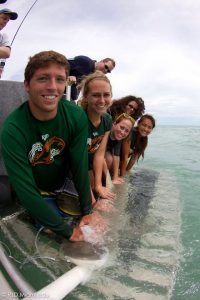
RJD interns, Jon, Megan, and Laurel, and volunteers from the Experience Aviation Group and the University of Miami Abess Center pose for a picture with a female Lemon Shark
We ended such a great day out on the water with some delicious cookies, “Curt-a-Sea” of Captain Curt! I can’t think of a better way to spend a Sunday than shark tagging in The Keys with my fellow RJD team and my new friends from Experience Aviation and the University of Miami Abess .

